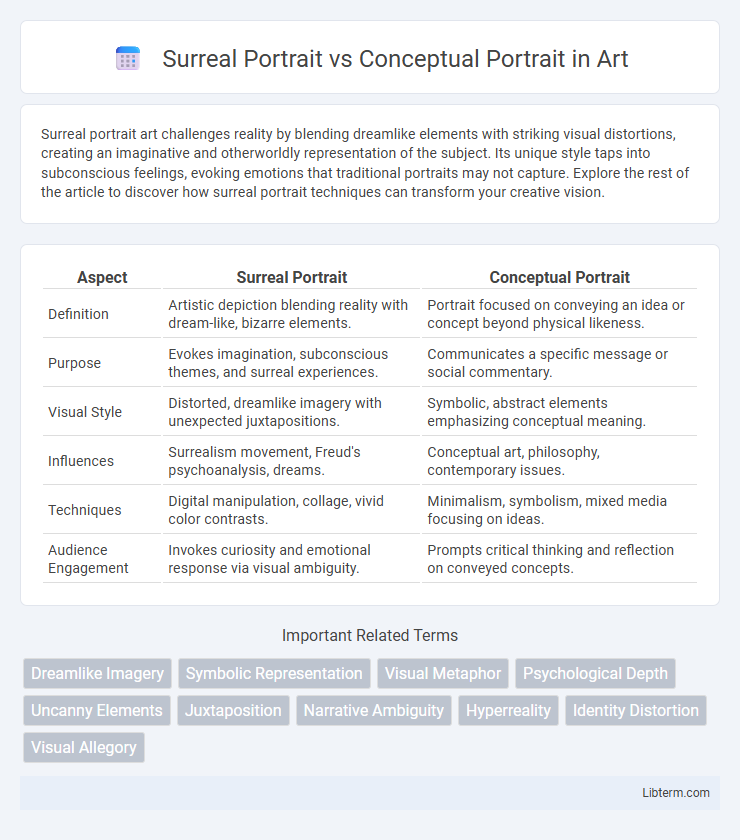Surreal portrait art challenges reality by blending dreamlike elements with striking visual distortions, creating an imaginative and otherworldly representation of the subject. Its unique style taps into subconscious feelings, evoking emotions that traditional portraits may not capture. Explore the rest of the article to discover how surreal portrait techniques can transform your creative vision.
Table of Comparison
| Aspect | Surreal Portrait | Conceptual Portrait |
|---|---|---|
| Definition | Artistic depiction blending reality with dream-like, bizarre elements. | Portrait focused on conveying an idea or concept beyond physical likeness. |
| Purpose | Evokes imagination, subconscious themes, and surreal experiences. | Communicates a specific message or social commentary. |
| Visual Style | Distorted, dreamlike imagery with unexpected juxtapositions. | Symbolic, abstract elements emphasizing conceptual meaning. |
| Influences | Surrealism movement, Freud's psychoanalysis, dreams. | Conceptual art, philosophy, contemporary issues. |
| Techniques | Digital manipulation, collage, vivid color contrasts. | Minimalism, symbolism, mixed media focusing on ideas. |
| Audience Engagement | Invokes curiosity and emotional response via visual ambiguity. | Prompts critical thinking and reflection on conveyed concepts. |
Defining Surreal Portraits
Surreal portraits emphasize dreamlike, fantastical elements that challenge reality and evoke subconscious emotions through unexpected juxtapositions and symbolic imagery. Unlike conceptual portraits, which focus on conveying a specific idea or message, surreal portraits blur the line between reality and imagination to create visually striking, provocative compositions. Techniques often include distortion, unusual color palettes, and blending of human features with surreal objects or environments.
Understanding Conceptual Portraits
Conceptual portraits prioritize conveying abstract ideas, emotions, or narratives through symbolic elements and carefully constructed compositions rather than capturing a literal likeness of the subject. Unlike surreal portraits that emphasize dream-like, fantastical imagery blending reality and imagination, conceptual portraits focus on intellectual engagement by representing themes or social commentary visually. Understanding conceptual portraits requires recognizing the intentional use of props, gestures, and settings designed to provoke thought and reveal deeper meanings beyond conventional portraiture.
Artistic Origins and Influences
Surreal portraits originate from the Surrealism art movement of the early 20th century, heavily influenced by the psychological theories of Freud and the exploration of dreams and the subconscious mind. Conceptual portraits, emerging later, focus on conveying ideas or messages through symbolic elements, drawing inspiration from conceptual art principles that prioritize meaning over aesthetic form. Surrealism's emphasis on irrational juxtapositions contrasts with conceptual portraiture's intentional use of visual metaphors rooted in social, political, or philosophical contexts.
Core Visual Elements Compared
Surreal portraits emphasize dreamlike, fantastical elements often combining unexpected juxtapositions and symbolic imagery to evoke subconscious emotions. Conceptual portraits prioritize ideas or narratives by using minimalistic or abstract visuals that directly convey the artist's message or theme. Both styles leverage composition, color, and symbolism but differ in intent: surrealism focuses on imaginative distortion, whereas conceptualism centers on intellectual engagement.
Symbolism in Surreal vs. Conceptual Portraits
Surreal portraits use symbolism to delve into the subconscious, often featuring dreamlike or fantastical elements that challenge reality and evoke emotional responses. Conceptual portraits employ symbolism to communicate specific ideas or social commentaries, utilizing visual metaphors to express complex themes and provoke intellectual engagement. Symbolism in surreal portraits tends to be ambiguous and open to interpretation, while in conceptual portraits, it is more direct and purposeful in conveying the artist's message.
Techniques and Approaches
Surreal portraits employ techniques such as digital manipulation, collage, and dreamlike juxtapositions to create imaginative and otherworldly visuals that challenge reality. Conceptual portraits prioritize conveying an idea or message through symbolic elements, staging, and minimalistic composition, often emphasizing expression or props to enhance meaning. Both approaches leverage creative visual storytelling but diverge in their focus on fantastical imagery versus intellectual or thematic communication.
Emotional Impact on Viewers
Surreal portraits evoke intense emotional responses by blending dreamlike elements with realistic features, triggering curiosity and a sense of wonder in viewers. Conceptual portraits rely on symbolic imagery and abstract ideas to communicate deeper psychological or social themes, often provoking introspection or critical thought. The emotional impact of surreal portraits tends to be more immediate and visceral, while conceptual portraits engage viewers through layered meanings and intellectual engagement.
Notable Artists in Each Genre
Salvador Dali and Rene Magritte are notable artists in surreal portraiture, renowned for their dreamlike imagery and distorted features that challenge reality. In conceptual portraiture, Cindy Sherman and Chuck Close stand out for their exploration of identity and technique, pushing boundaries through staged photographs and hyper-realistic paintings. These artists exemplify the unique approaches and thematic depth within their respective genres.
Modern Trends in Portrait Photography
Surreal portraits in modern photography emphasize dreamlike, imaginative visuals that challenge reality, often using digital manipulation and creative props to evoke emotional and psychological depth. Conceptual portraits prioritize the communication of abstract ideas or social messages through symbolic elements, staged settings, and intentional composition. Both trends reflect a shift towards narrative-driven imagery that transcends traditional portraiture by blending artistry with thematic storytelling techniques.
Choosing Between Surreal and Conceptual Styles
Choosing between surreal and conceptual portrait styles depends largely on the desired emotional impact and narrative depth. Surreal portraits often utilize dreamlike, imaginative elements to evoke subconscious feelings and challenge reality, making them ideal for artists exploring fantasy or psychological themes. Conceptual portraits focus on conveying a specific idea or message through symbolic imagery and composition, appealing to viewers interested in intellectual engagement and social commentary.
Surreal Portrait Infographic

 libterm.com
libterm.com